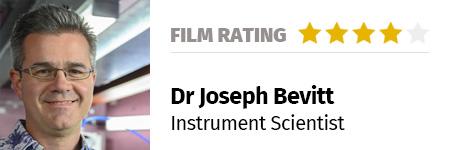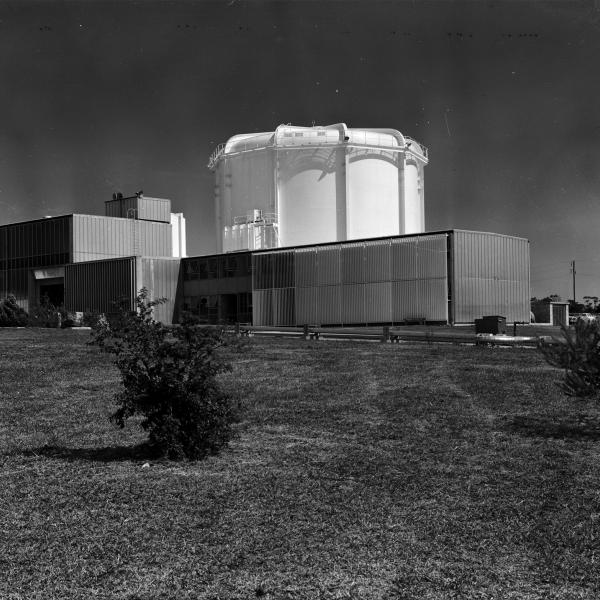

Published on the 26th July 2023 by ANSTO Staff
In part 1 of this two-part series, ANSTO scientists from across the organisation became film critics to review Christopher Nolan’s new movie, Oppenheimer, which explores the life of the director of the Manhattan Project to develop an atomic weapon.
In part 2, we explore more of the thoughts captured by ANSTO’s scientists. Overall our reviewers, who took to the task with enthusiasm, were impressed with Nolan taking on a complex subject and individual—delivering a thought-provoking film but would have preferred more of a depiction of the physics involved.

Instrument scientist Dr Rachel Williamson, who undertook some postdoc work at Los Alamos National Lab (LANL) using stable isotope analysis earlier in her career said, “I wasn’t focused on the nitty-gritty of the science (I’m a chemist, not a quantum physicist!), but I did enjoy watching a science, or rather, a scientist-centred movie with a strong emphasis on how pivotal scientific events, whether for good or bad, shape our world. The Atomic Age, which we all live in today, began with Oppenheimer and his team’s successful test at Trinity Site.
“I had a particular interest in seeing the movie because of the time I spent working at Los Alamos National Laboratory. Oppenheimer loomed large in the mythos of Los Alamos, along with the unfairness of his treatment after his incredible efforts in the Manhattan Project era. It was uniformly agreed that no one apart from Oppenheimer could have brought together and led that team to achieve such an outcome within the timeframe that they had.
“I did enjoy the depiction of science leadership in the film, and how much depends on building the right team, such as knowing who you need to bring in and when and trying to remove any barriers in the way. Interestingly, to this day, Los Alamos National Laboratory recruits scientists from all over the world.
“For me, Nolan’s film packed a truly emotional punch when depicting the political machinations involved in tearing Oppenheimer down and rescinding his Q clearance, effectively shutting down his career and removing his platform. I thought the film did a great job of showing the tension between politics and science (and how inconvenient we scientists can be).
“A lighter moment in the film was when Oppenheimer talked about combining New Mexico and physics. New Mexico is a beautiful area filled with incredible scenery. Whilst at Los Alamos, I made the long journey down to the south of New Mexico to Trinity Site, a place with its own strange empty beauty, and I stood at ground zero.
“Where a tower containing a bomb once stood, there is now a slightly underwhelming stone obelisk. It does seem odd to me that Oppenheimer chose to detonate the gadget in New Mexico, a place so dear to his heart. But he was a man of contradictions, and I think Nolan’s film was brilliant at conveying just how complicated and contradictory he was.”

Dr Ceri Brenner, Leader of the Centre for Accelerator Science, said that she enjoyed and appreciated the snippets of science that were included in the script and the visuals to explain some of the main physics themes that are central to this story.
"They were short but sweet and got the right balance of inclusivity while maintaining flow and pace needed for a film that packed a lot in. For example, the explanations of fission and fusion, and the introduction to the paradox of light being both a particle and a wave that Oppenheimer gave to the one student who turned up for his first lectures in the US, were key to the story.
"This underlying principle of quantum physics was striking within the physics community at the time and still remains a mysterious idea for those outside that have never come across it before (which is most people who haven’t studied physics, maths and chemistry).
"I also enjoyed the discussion of theory vs experiment and another aspect of science that came across but not often gets airtime: that when we are doing something for the first time, it’s often that you get it wrong a hundred times before you get something right and make progress.
"The process of discovery and innovation is a winding road, full of dead ends and potholes, and certainly not a smooth straight line. Group discussion, such as peer review, is our process in science for challenging ideas and findings, so it was good to see this included in the storyline.
"The only thing that I would have liked to see, and would have been a key science communication opportunity, is that when the device went off, we got the flash of light and the silence, but I didn’t notice anyone reacting to the immediate experience of heat that accompanied the visual of the flash.
"The energy emitted from fission is radiative and carried long distances via electromagnetic radiation, which travels at the speed of light, compared to conductive or convective heat that propagates more like the sound wave boom that arrived shortly after. I saw a documentary where someone described it as being similar to opening an oven door and feeling the immediate bath of heat emerging. "

Dr Mitra Safavi Naeini, saw the film in Japan, where she is undertaking research relating to the anti-cancer therapy treatment NCEPT she co-developed.
“The movie ends with a dialogue between Oppenheimer and Einstein, the essence of it summarised by another one of Oppenheimer's quotes from the Bhagavad Gita, "I have become death, the destroyer of worlds".
“We do not get a primer on fission, quantum mechanics or particle physics. Instead, Nolan depicts the real-world experience of theoretical physicists convincingly, focusing on both their individual journeys and their collective dynamics. The film captures Oppenheimer as an intellectually curious individual, captivated by quantum mechanics and deeply engaged with various areas of science, including astrophysics, spectroscopy, and nuclear physics.
“In an interesting cross-reference, Nolan has used models developed by Oppenheimer and his student, Snyder, to illustrate star collapse and the creation of a black hole, an aspect we've seen in his earlier movie Interstellar.
“I was struck by how well the movie handles the influence of external events on personal trajectories. Oppenheimer, initially an academic, is thrust into a leadership role by the onset of World War II. The story doesn't shy away from depicting his humanity, showing him as a complex individual with many facets.
“The film sets its drama against a background of a world in turmoil. With the rise of Nazi Germany, many renowned physicists, including Einstein and Born, were forced to flee (a few, like Heisenberg, stayed behind). These refugee scientists, exiled and concerned, played a pivotal role in alerting the world to the growing Nazi threat.
“The depiction of the Kangaroo Courts, which handled the theme of suspicion and guilt by association, using the example of Oppenheimer's security hearing, was striking.
“In my opinion, Oppenheimer asks an important question: ‘Should decisions with cataclysmic potential be left to individuals with their own agenda?’

"What an epic and intense movie!" commented Instrument scientist Dr Joseph Bevitt.
"In societal memory, the enormous endeavour to split the atom and control the reaction was overshadowed by the horror of subsequent weaponisation— Hiroshima, Nagasaki and the Cold War. Nolan was right to focus on the events leading to the singular achievement of the Trinity demonstration on July 16, 1945.
"The film is centred around the complex psychological trauma, ethical dilemmas and political challenges experienced by theoretical physicist J. Robert Oppenheimer. 'Oppie' was the Director of the Manhattan Project, who was later castigated by political opponents.
"As a scientist who has studied the relevant mathematics and work of key scientists who participated in the Manhattan Project, I was absolutely engrossed by Oppenheimer, its characters and the suspense leading to one of the greatest collaborative feats in human history.
"To anyone who has not prepared for the film, including three of my four family members who attended with me, its abstract scientific complexity and the depiction of obsessively driven characters were thought-provoking, fascinating and terrifying. Oppenheimer demands a second watch.
"At the end of the three hours, I asked, ‘Is that it?’. I craved more. But why? The significance of the Chicago pile reactor, built under stadium seating, was glossed over. The first criticality of the X-10 reactor at Oak Ridge National Lab, the contributions of Enrico Fermi, and so much more, were omitted.
"The ramifications of the atomic bombings for humanity were suggested, but I needed closure. The formation of the “Atoms for Peace” program, the establishment of the International Atomic Energy Agency, and the positive real-life impacts that atomic research and neutron science have on everyday health and technological advancement followed those events.
"It is easy to be critical of the film and what it omits. Watch it for what it is: a modern-day tragedy and historical account of one of the most intense moments in human history, seen through the eyes of a brilliant and tortured mind torn between the passion for the science he loves, and the things he cannot control."
